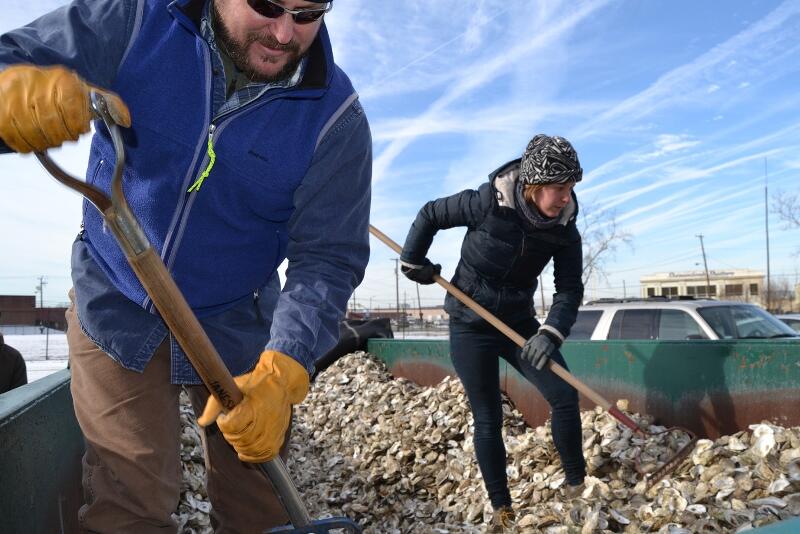
Feb. 6, 2014
Don’t chuck that shuck!
Share this story
The VCU Rice Rivers Center celebrated Richmond’s 6-ton taste for oysters last week with more than 20 volunteers at the city’s recycling center.
They shoveled nearly 12,000 pounds of oyster shells collected at Richmond restaurants and events since mid-August to transfer the collection to the Virginia Offices of the Chesapeake Bay Foundation (CBF). The foundation will use the shells in the Virginia portion of the Chesapeake Bay for wild oyster restoration.
“This quantity of shell is very significant to us,” said Jackie Shannon, Virginia CBF oyster restoration specialist, “The amount of shell generated in Richmond in four months is equal to the total annual donations from all of our Virginia partners combined.”
Restaurants and events that contributed to Richmond’s substantial oyster slurping – and then saving – were Rappahannock Restaurant, Lemaire at the Jefferson Hotel, Acacia Mid-Town, Pearl Raw Bar, the 17th Street Farmers Market, Shockoe on the Half-shell Oysterfest, St. Thomas Episcopal Oystoberfest and the Richmond Folk Festival.
The stockpile of shells will aid the wild Eastern Oyster, also referred to as the Virginia Oyster. Today, the population of this oyster is estimated to be at only 1 or 2 percent of its 19th century peak population, when the harvest was approximately 17 million bushels per year and represented a significant portion of the Chesapeake Bay economy. Overharvesting, disease and other factors have ravaged the bay’s oyster population since that time, but the population has started to make modest gains in the past decade – which is good news for the bay.
A single oyster filters 50 to 60 gallons of water per day and 30,000 gallons during its lifetime. In addition, oyster reefs provide hard safety and feeding habitats for fish and crabs while also protecting shores from erosive waves.
In the days of explorer John Smith, oysters were so prevalent in the bay that oyster bars stuck out of the water at low tide and there were enough of them to filter all of the bay’s water in three days. The water then was much cleaner and clearer than it is today, which also had to do with less runoff.
So why then, after the oyster population’s devastation and scientists learning all of the benefits these small creatures contribute, is it a good thing that Richmonders are devouring nearly six tons every four months?
Most of the oysters consumed in Richmond are farm-raised in natural estuaries, said Todd Janeski, program manager for the Virginia Oyster Shell Recycling Program at the VCU Rice Rivers Center. And farmers are replacing the oysters in their farms at a rate of 10 to 1.
So eating three dozen oysters, he points out, is like sponsoring 1 million gallons of filtered water.
To multiply the positive effects of shucking in RVA, Janeski and his team are returning the shells to an oyster sanctuary where they cannot be harvested. They’re also kick-starting the reproduction process by seeding the shells with oyster larvae before placing them – an extra step that very few, if any, Virginia oyster recycling programs are taking.
Natural oyster shell is the preferred substrate for growing new oysters, but many restoration projects rely on reclaimed clam shells, crushed concrete or reef balls as surrogates.
“When oysters reproduce they need hard surfaces,” Janeski said. “But real shells also provide the nutrients needed to grow and thrive.”
The VCU Rice Rivers Center piloted the successful regional effort that collected the oyster shells, which were originally directed to landfills. Volunteers from the Virginia Master Naturalists and Volunteers as Chesapeake Stewards (VoiCes) collected the shells after the participating restaurants and events saved them.
Volunteers continue to collect the shells, but for now there is not an option for the general public to drop off shells. Janeski hopes to change that soon as he also hopes to expand the contributing network with more restaurants and even grocery stores. All told, he estimates there could be as much as 100,000 pounds of untapped oyster shells in the Richmond region.
Expansion is contingent upon having the appropriate resources, so a fundraiser – which ideally will be the first of many – is planned for May 18 at Tuckahoe Plantation
But of course those who want to help can always just go out and shuck a few.
Editor’s Note: VCU Rice Rivers Center partnered with Virginia Green Travel Program, Chesapeake Bay Foundation, City of Richmond, Tidewater Fiber Corporation, Virginia Master Naturalist Program, Virginia Coastal Zone Management Program, Rappahannock River Oyster Company and the restaurants and events listed above to make this oyster preservation project a success.
Subscribe for free to the weekly VCU News email newsletter at http://newsletter.news.vcu.
Subscribe to VCU News
Subscribe to VCU News at newsletter.vcu.edu and receive a selection of stories, videos, photos, news clips and event listings in your inbox.







